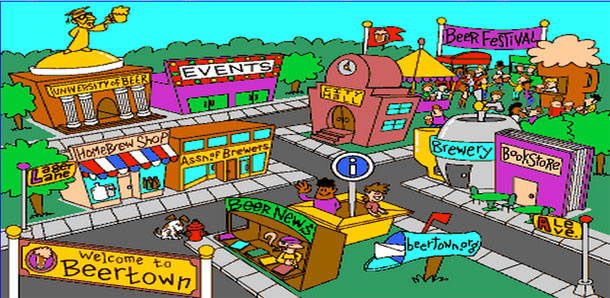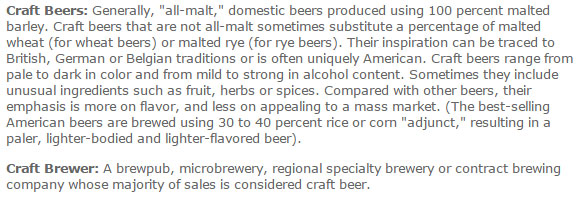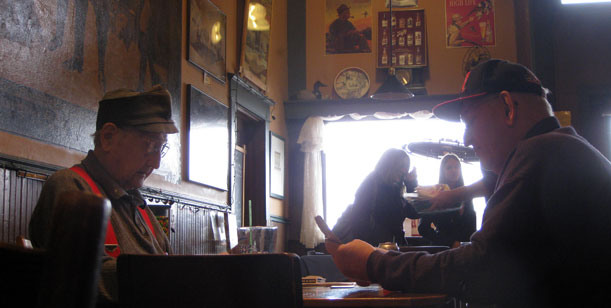Paste Magazine has a rather comprehensive post today which is pretty much what the headline says: “A Not-So Nefarious History of Craft and Crafty Beer.” I don’t need much of an excuse to dig into the personal archives. So here’s something I wrote for All About Beer in 1997, as is, without the benefit of a safety net the rear mirror can provide.
The subhead on this story read: “What happens when the large breweries enter the ‘little guys’ territory?”
Scene 1: A church-run festival in Covington, La.
Boiled crawfish cost $1.25 a pound, Rockin’ Dopsie Jr. is pounding out zydeco, and cups of beer sell for $1.50 each. The choices are Budweiser, Bud Light and Michelob Hefeweizen. When a customer orders the hefeweizen — and quite a few do — the man taking the orders turns to the pourer and says: “One heavyweight.”
Scene 2: Applebee’s Grill & Bar, Milwaukee, Wis.
A customer orders a beer called B. Barley’s, which recently became available on tap at Applebee’s around the country. The tap handle includes the information the ale is brewed by Jacob Leinenkugel Brewing Co. Although B. Barley’s is made exclusively for Applebee’s and available only on tap, when the customer returns home to northern Wisconsin he tries Leinenkugel’s Auburn Ale from a bottle, which is not exactly the same beer but similar.
Scene 3: Cyberspace.
The brewers from Anheuser-Busch Specialty Brewing Group are conducting a live tasting of Michelob Specialty beers on the Internet, providing frank and specific answers to questions about A-B products. Somebody in Orlando, Fla., wants to know why Crossroads, a beer test-marketed in 1995, was never put into full production. Brewer Steve Michaluk notes the beer may have been “ahead of its time,” and that it was much closer in style to a Bavarian hefeweizen than the current Michelob Hefeweizen.
Michaluk and Mitch Steele make it clear they are nonetheless proud of the second beer and delighted with its malt character and the influence of Cascade hops. “American hefeweizen might be more aptly named American wheat ale,” Michaluk types, “which is what our Michelob Hefeweizen is and what most of the hefeweizens popular in the Northwest are.”
The largest breweries in the United States are sending their specialty beers where they haven’t gone before, often where no specialty beers have gone. While those at smaller breweries watch with understandable concern, in most parts of the country the short-term result has meant more choices for consumers. “The good news is that more people will be able to get good beer,” said American Specialty Craft Beer Co. manager Scott Barnum, who oversees the specialty brewers that Miller Brewing Co. owns partially or in total.
First, it’s a business
Beer lovers shouldn’t forget a key ingredient in the explosion in their number of choices — there’s money to be made selling beer. Anheuser-Busch is in business to make money, as are Miller Brewing Co., Sierra Nevada Brewing Co., Three Floyds Brewing Co., Two Brothers Brewing Co. and more than 1,000 other breweries in the United States. So are the importers, wholesalers, brewpub operators, bar owners and retail store proprietors.
That’s why the Wall Street Journal and major metropolitan newspapers publish stories about the business of beer, pondering macros going micro and micros going macro. But why should you care about the battle for shelf space in retail stores and tap handles in bars? That six-pack of Michelob Amber Bock in the cooler in a Nebraska gas station didn’t replace a beer from Pyramid or Rogue. It replaced a cold six of some beer you weren’t going to buy.
That’s not the way some smaller brewers and their supporters look at it. They heard those Anheuser-Busch ads that attacked the Boston Beer Co. and are well aware that A-B has made it clear it expects its distributors to focus on selling A-B products. Since A-B and Miller distributors carry enormous clout with retailers, it’s natural to wonder how much room will be left on the shelves and at the bar for small brewers’ beer.
Investors flocked to buy microbrewery stocks two years ago based on future growth in the “high price” segment. The potential for growth remains, but Robert Weinberg — a mathematical economist who consults for both large and small breweries — recently warned microbrewers about making predictions.
“The battlefield will not be in the high price segment. The major brewers will try to re-establish the super premiums,” Weinberg said at the National Craftbrewers Conference in Seattle. “You will be competing with a super premium that doesn’t currently exist.”
Budweiser is a premium beer, Michelob a super premium, and most micros high price. “As the relative price of malt beverages declined, consumers were willing to trade up,” Weinberg said. A-B understood this when it rolled out the Michelob specialty beers. “We have seen some cannibalizing,” said Bob Franceschelli, senior brand manager of the Specialty Brewing Group, meaning that the brewery was essentially stealing sales from itself. “We’re going to end up moving a lot of people into the micro/specialty area. Were they going to move anyway? Probably.”
Deja vu all over again?
Haven’t we seen different beers from the large brewers before? Miller test-marketed Dakota, a wheat ale, in the 1980s. “It was a very good beer. You could drink a lot of it. Very satisfying,” said Jim Robertson, author of the Beer Taster’s Log. “It was an American wheat beer — no cloves or bananas, but it went down smooth.”
The beer simply couldn’t get a hold in any market. “A company not only has to have a good product, but the market has to be there, too,” Barnum said.
Anheuser-Busch tested a variety of beers in the 1990s, including Anheuser Maerzen and Anheuser Pilsner in 1990 and Crossroads in 1995. Robertson remembers when he tasted the Maerzen for the first time. “I thought, this is a classical Maerzen and that these guys could wipe out anybody they wanted,” he said.
Muenchener Munich Style Amber, which the brewery introduced with its American Original beers in 1995, earned three stars (out of four) in Michael Jackson’s Pocket Guide to Beer, but has already been discontinued. Likewise the Elk Mountain beers.
So is it safe to fall in love with any of the latest efforts? A-B is used to selling very large amounts of every beer it makes. Beer is brewed in batches of 400 barrels at it Merrimack, N.H., plant, 500 barrels in Fairfield, Calif., and 750 barrels in Fort Collins, Colo., the three sites where the specialty beers are made. That’s more than was produced of some of the most highly praised microbrewery beers in all of 1996.
Franceschelli said the brewery’s expectations have changed since those earlier tests. “Absolutely. It’s been a huge learning curve,” he said. When the Michelob specialty beers were introduced in February, “we told (distributors) one case in an account is outstanding. Start with one bottle.”
Anheuser-Busch appears to have learned a few things from smaller brewers. In April it rolled out sampler packs of the Michelob specialty beers. It also packaged the draft beer in one-sixth-barrel kegs (one-third the size of most kegs), finding room in crowded taproom coolers and moving the beer while it’s still fresh. Micros and homebrewers have long used smaller kegs, often reconditioned five-gallon soda kegs.
Putting the special in specialty
Although the Stroh Brewery Co. sells a lot more of its own beer, its leadership knows a little bit about the craft beer market. Stroh brews much of the beer for Pete’s Brewing Co., Boston Beer Co. and its Oregon Ale and Beer Co. It brews and sells the Henry Weinhard and Red River specialty beers. It even makes some of the Black & Tan beer sold by D.G. Yuengling & Son, America’s oldest operating brewery.
“We have to do things differently, to look for niches,” said Mark Steinberg, vice president of sales at Stroh. Anheuser-Busch and Miller have more advertising dollars to support their specialty beers, but don’t have the sales to justify the costs. “Besides, if they spend too much, the beers lose their specialty,” Steinberg said.
“There’s something about a customer going into a bar and finding something new,” he said. “People like the sense of discovery in this category.”
Anheuser-Busch, Miller and Coors Brewing Co. have all taken different approaches. Coors’ Blue Moon beers command micro prices and are available in all 50 states. They include funky styles consumers expect from micros — such as a pumpkin ale and raspberry cream ale — but also a Belgian white, a nut brown ale and, most recently, an abbey-style ale. The beers were first developed at the SandLot Brewery at Coors Field in Denver, then brewed under contract at other breweries. Rumors abound that Coors will soon buy a small brewery to produce the Blue Moon brand beers.
Miller’s strategy for selling in the specialty category has been through partnerships. The Reserve line it brewed itself in the early 1990s is long gone, and the brewery has no plans to make specialty beers. “I can never say never, but as this juncture, no,” Barnum said.
Although each of its first three partners is different, that doesn’t mean Miller has been building an overall portfolio to take national. “We’ve said before that this is a regional business,” Barnum said. “More and more, you will see people contracting, narrowing their focus.”
When Miller acquired a majority interest in the Celis Brewery in 1994, the Austin, Texas, brewery was selling its distinctive Belgian-style beers in more than 30 states. Miller cut that down to a handful of states. “They were allocating beer to their distributor in Austin. You can’t build a business like that,” Barnum said. Now that the brewery has added capacity and taken care of its home market, it is available in 14 states. “Celis does well in micro-favorable markets where Pierre (Celis, the brewery’s founder) is known and revered,” Barnum said.
The stories for Shipyard Brewing Co. and Jacob Leinenkugel are different, but similar. Shipyard, brewer of traditional British ales, is available in 12 states. Leinenkugel, the seventh-oldest brewery in the nation and known almost exclusively for its lagers despite the B. Barley’s ale, is sold in 27 states (plus draft in Applebee’s in some other states), but is strongest in its Wisconsin home and the surrounding states.
“You can’t be all things to all people,” Barnum said. At Miller that has also meant deciding which is the macrobrewery and which is the micro (you’ve seen the ads).
“The consumer has a hard time paying an above-premium price for a beer brewed at a larger brewery,” Barnum said.
One from column A, two from column B
The leadership at Anheuser-Busch obviously doesn’t believe that, although A-B has also gone into the strategic alliance business. A-B not only brews the Michelob Specialty beers and the American Originals, but is testing other recipes that take direct aim at the high price market. Its ability to put these beers in the pipeline is evident across the country. Not only will you find the Michelob specialty beers in the cooler at a gas station in Baton Rouge, La., but you’ll find beer from the Redhook Ale Brewery as well.
A-B owns a 25 percent share of Redhook, with the right to buy more. As summer began, A-B and Widmer Brothers Brewing Co. were working on finalizing a similar deal. “We have and are talking to more breweries out there. We are being approached quite regularly by these people,” Franceschelli said. While others figure A-B has the money simply to buy up the competition, the deals won’t come that fast. “We make more on what we brew ourselves,” Franceschelli said.
The five Michelob specialty beers released nationally will shock the taste buds of drinkers stepping up from Budweiser and its brethren. Bud, for instance, checks in with 12 International Bittering Units, a measurement of hoppiness. The Amber Bock, Pilsner, Pale Ale and Hefeweizen are all 30 IBUs. The Honey Lager, which goes heavy on the honey, is 12.5 IBUs. The result is that the Pale Ale, which is hopped with American versions of noble European hops, tastes more like a golden ale, while the Hefeweizen, hopped with Cascades and Clusters, hints of a pale ale. The Pale Ale and Hefeweizen are made with the same yeast.
Core microbrewery drinkers often want beers with more pop. The Michelob beers are “not intended to … knock your tonsils out,” Franceschelli said. Steele, the Specialty Group brewmaster, agrees. “The American Originals are a notch above the Michelob brand in intensity,” he said. The American Hop Ale is 5.6 percent alcohol by volume and 50 IBUs. It’s dry-hopped with a healthy dose of American Fuggles. The Black & Tan Porter is the best selling of the “Originals” and hoppier and more complex than the Michelob Porter currently available only in the Northwest.
The most interesting of the current A-B beers is the Pacific Ridge Pale Ale, brewed in Fairfield, Calif., and available only in Northern California. The beer has been called a Sierra Nevada clone, though Steele said it wasn’t brewed as an exact copy. “Our wholesalers asked us for a beer like this … what we were going for was something of that style. I think Sierra Nevada is the best of that style that’s out there.”
The numbers for the beers — Sierra Nevada, 5.5 percent ABV, 39 IBUs; Pacific Ridge, 5.6, 35 — are similar, and so is the taste. Dry-hopping with Cascades gives Pacific Ridge the citrus quality that makes a beer drinker think of Northern California. But like all A-B ales, Pacific Ridge is pasteurized and lacks the yeast character of Sierra Nevada Pale Ale. SNPA regulars aren’t likely to mistake the two.
“Pacific Ridge has good opportunities to be expanded,” Franceschelli said. “You will see some new beer before the end of the year.”
These may or may not be labeled Michelob or American Originals. Steele offered some test batches to members of the press in May. Included were a British-style pale ale, an Irish “creme ale” that is conditioned with nitrogen and meant to be dispensed via a Guinness-type system, a spiced winter lager, and a Scotch ale that seems to be a good candidate for reaching the public.
The Scotch ale got good reviews at another press gathering last November, when it was being made on A-B’s 15-barrel pilot system in St. Louis. August Busch III reportedly likes the beer, and the batch Steele showed off in May was made at the Merrimack facility, indicating it’s a step closer to being released. “We’re making the effort,” Steele said, smiling. The beer contains so much malt that it’s mashed in two vessels, then combined into the brew kettle. Two kinds of caramel malt and chocolate malt make the beer more complex than any of the current A-B efforts. The recipe produces a beer that is 7 percent alcohol by volume, which would present distribution problems in some states.
At the turn of the century, A-B brewed 17 brands of beer, ranging from the Hop Ale (which was a low-alcohol temperance beer also sold by mail order) to the Black & Tan Porter. “They were mostly lagers,” said A-B archivist Bill Vollmar. While the brewery could keep turning out beers based on those old recipes, the test batches from Steele and Michaluk focus on new recipes. “There’s a demand for (more choices) and we’re going to satisfy that,” Franceschelli said.
Those crowded shelves
Smaller breweries hope Anheuser-Busch doesn’t try to supply all the choices itself. Of course, craft breweries with shelf clout, such as Boston Beer and Pete’s Brewing, have been adding “year round” beers for the last several years. Much of the battle for space is among microbreweries themselves, and recently that has sparked plenty of teeth-gnashing.
“Everybody I talk to is waiting for the great shakeout,” said Peter Fremming, beverage coordinator at Premier Gourmet in Buffalo, N.Y. “I just don’t see that happening.”
Premier Gourmet sells more than 500 different beers, most of them by the case, six-pack or single bottle, as well as prepared gourmet foods, cooking ingredients and supplies, 90 varieties of coffee roasted in the store, and much more. It’s not at all like the grocery store down the block, but Fremming previously worked for a beer distributor, so he understands how those salespeople think.
“They know that if you lose one bottle facing (placement) on the shelves, it means so many lost case sales,” he said. The battle in the supermarkets is not just to squeeze out beer competitors, but for continued cooler space. “They have to give the supermarkets something new to sell, or they cut four feet off the beer cooler and put in more eggs and cheese,” Fremming said.
Now, the battle for space among specialty egg dealers, that’s a whole ‘nother story.


